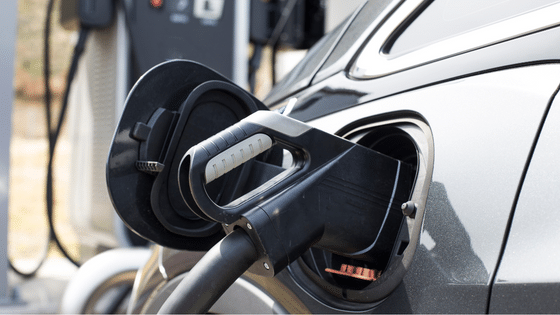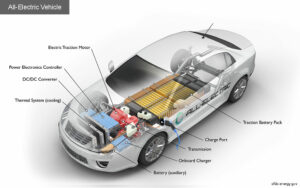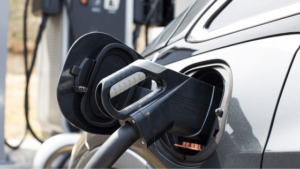
Are the parts of an electric car the same as a gas-powered vehicle? What are some of the main components of electric vehicles (EV), and what materials are they made from? We’re seeing an upswing of interest and investment in electric powered vehicles and the infrastructure needed to support them. And with it, a slew of questions about how they work! Let’s dive in.
Many of the parts of a gas powered vehicle and an electric car are made with aluminum sheet, stainless steel, and advanced high strength steels and ultra high strength steels. But, when you go to start the engine of a traditional gas car you’ll probably notice a loud rumble, letting you know the engine’s working. Gas powered cars have a fuel pump, fuel line, or fuel tank that store and transport liquid fuel. When you rev a gas powered engine you’re sending fuel through the motor which results in tailpipe emissions.
Kloeckner Metals is a leader in sustainability and we’re developing programs that will help our customers reduce their carbon footprint and add transparency to their sustainability mission. Contact us now to learn more.
The United States Environment Protection Agency (EPA) calculates that a typical passenger vehicle emits about 4.6 metric tons of carbon dioxide each year. They clarify that this calculation assumes that the average gasoline vehicle has a fuel economy of about 22.0 miles per gallon and is driven around 11,500 miles each year. But of course, not every vehicle on the road today meets that gas mileage, and many people drive more than 11,500 miles a year. To get a more accurate picture of the greenhouse gas emissions from a vehicle, the EPA provides a more specific calculation: each gallon of gasoline burned results in about 8,887 grams of CO2.
This sole reliance on gas to power the vehicle is the main difference between EV and gas powered vehicles. This requires system designs that support fuel distribution throughout the vehicle—parts that become unnecessary in an all-electric vehicle. EVs have a rechargeable battery instead of—or in some cases, alongside—an internal combustion engine.
Perhaps one of the more important myths to bust about electric cars is that they are all the same! There are three main types of electric cars: all-electric vehicles, also called battery electric vehicles (BEVs), plug-in hybrid electric vehicles (PHEVs), and hybrid electric vehicles (HEVs). Each type of electric car has a unique design, and key components.

All-electric vehicles (BEVs) do not produce tailpipe emissions. Instead of a combustion engine, BEVs have a large traction battery. This powers a quiet electric motor. BEVs will not run if the battery hasn’t been charged. Conveniently, most BEVs have a plug that can plug into the same outlet as your phone!
The U.S. Department of Energy, Energy Efficiency & Renewable Energy outlines the key components of all-electric vehicles:
PHEVs have an internal combustion engine as well as an electric motor. They have batteries that power the electric motor, and permit operations mimicking an all-electric vehicle. This type of electric car can run in charge-depleting mode, with batteries that charge with regenerative braking and when plugged into charging equipment.
Most PHEVs can travel between 20 and 60 miles on electricity alone. After this, they operate solely on gasoline. Sometimes, especially when battery charge is low, the combustion engine powers the vehicle through rapid acceleration and also when heating or air conditioning use is high. However, some model and manufacturer variability in PHEVs swap these roles—using gas to power the vehicle and electricity to run the AC and heating units.

There are a number of ways that PHEVs combine engine power and electric power. The two main configurations are called parallel and series fuel-efficient system designs:
The parts of an electric car that has both the capability to charge through a external charging port and gas has the same components as the all-electric vehicle plus these:
HEVs are similar to PHEV’s with one main exception: the battery cannot be charged by being plugged into an external charging source. Rather, regenerative braking charges the vehicle.
Regenerative braking allows the vehicle to capture energy it would normally lose during braking. It uses the HEV’s motor as a generator and stores the captured energy in the battery.
Components of electric vehicles with this hybrid structure are the same with the exception of the added electric generator. This part of an electric car generates electricity as the wheels rotate while braking. Then, the electric generator returns that energy back for storage in the traction battery pack.
The automotive industry faces challenges in EV manufacturing. EVs must meet structural soundness requirements, be affordable enough to produce and reasonably priced for consumers to buy, demonstrate rust resistance, and offer consumer appeal consistent with changing trends.
Technological advancements achieved with aluminum, advanced high strength steels, and ultra high strength steels (AHSS and UHSS) can be found in automotive closure panels, automotive body structure, seat structure, electrical battery structures and enclosures, and more! (Curious exactly which aluminum grades go where? Check out this handy infographic guide to automotive aluminum sheet). Together these cutting edge materials are making it possible for automotive manufacturers to build cars with better range while continuing to meet rigid safety standards.
Kloeckner Metals is a leader in sustainability and we’re developing programs that will help our customers reduce their carbon footprint and add transparency to their sustainability mission. Contact us now to learn more.
However, an upsurge in demand for electric vehicles means manufacturers must navigate complex supply chain bottlenecks in order to bring them to market. This centers complex supply chain solutions as a critical factor in determining automotive manufacturers’ future success. Kloeckner leads in raw material processing for the automotive industry, supplies the aluminum in cars and AHSS/UHSS products playing a big role in parts of electric cars, all the while simplifying complex supply chains.

Steel base plates are fundamental elements employed in various manufacturing...
Metal fabrication is a critical process that transforms raw metal...
The solar industry has undergone a significant transformation by incorporating...

X
The Kloeckner Metals website uses modern technologies. Unfortunately, your browser doesn't support those technologies.
Download the latest version of one of these browsers to experience the site: